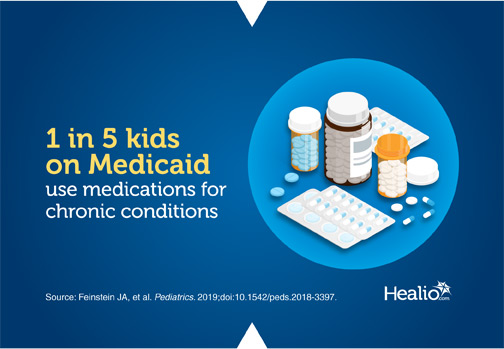1 in 5 children on Medicaid use chronic medications, study finds

A recent retrospective cohort study found that nearly one in five children on Medicaid use chronic medications, and that using multiple chronic medications was associated with increased health care use in children on Medicaid.
“A large proportion of chronic medications (eg, stimulants, antidepressants and antipsychotics) are prescribed to support mental and behavioral health in pediatric Medicaid enrollees,” James Feinstein, MD, MPH, assistant professor of pediatrics at the University of Colorado School of Medicine, told Infectious Diseases in Children. “It should be a reminder to us as pediatric providers that we need to thoughtfully prescribe and monitor these medications, discontinue them when appropriate, and perhaps most importantly, make sure that we don’t rely solely on psychiatric pharmacotherapy; we must complement medication use with appropriate counseling, therapy and social supports.”
Researchers followed children from 10 states aged 1 to 18 years who were continuously enrolled in Medicaid or in the Children’s Health Insurance Program’s fee-for-service and managed care plans in 2014. They were grouped by the annual number of unique chronic medications (CMs) they used. CMs were defined as a filled prescription for at least 30 days with two or more refills for the same generic drug throughout the study period. Health care spending and use were also assessed in the study.
Researchers found that among the 4,594,061 children on Medicaid who were included in the study, 18.8% used CMs. Among those with CMs, 52.2% used one CM, 40.3% used two to four CMs, 7% used five to nine CMs, and 0.5% used 10 or more CMs. The central nervous system therapeutic group, which included antidepressants, antipsychotics, stimulants and antiepileptic medications, made up 28.9% of all CMs. A total of 44.4% of children with complex chronic conditions used CMs.

Older age was associated with use of more CMs, the researchers said. Increased CM use was associated with increased ED use (32.1% to 56.2%) and hospitalization (2.3% to 36.7%). Children with multiple CMs accounted for 59.3% of Medicaid’s $2.3 billion in pharmacy spending in 2014.
“When we prescribe children new acute or chronic medications, we as prescribers require higher quality pediatric-specific information about optimal dosing schedules, interactions of multiple drugs and their risks, and monitoring parameters,” Feinstein said. “Furthermore, we must evaluate potential strategies to manage chronic medication use in at-risk children, and then assess the impact of these strategies on clinical outcomes, health care use, and the families and caregivers who administer complex medication regimens.” – by Erin Michael
Disclosure: Feinstein reports receiving support from the Eunice Kennedy Shriver National Institute of Child Health & Human Development of the NIH under award number K23HD091295. This information or content and conclusions are those of the author and should not be construed as the official position or policy of, nor should any endorsements be inferred by, the NIH or the U.S. government.
